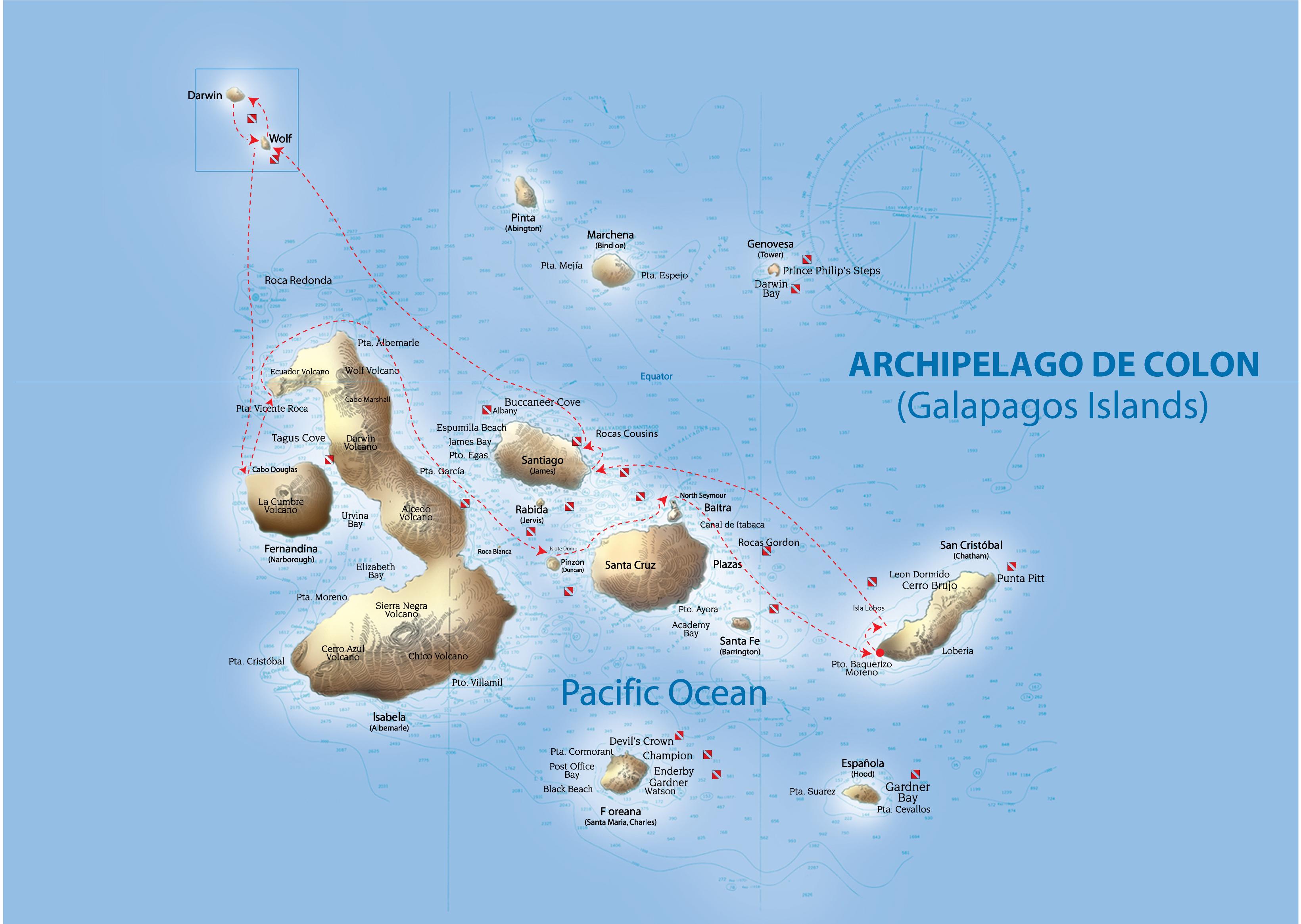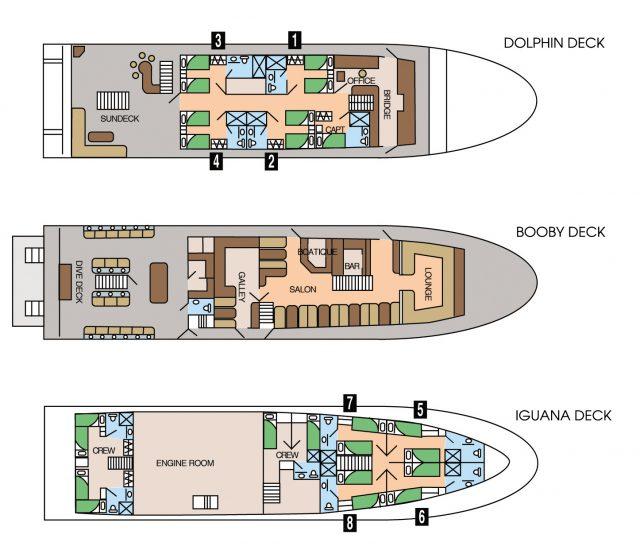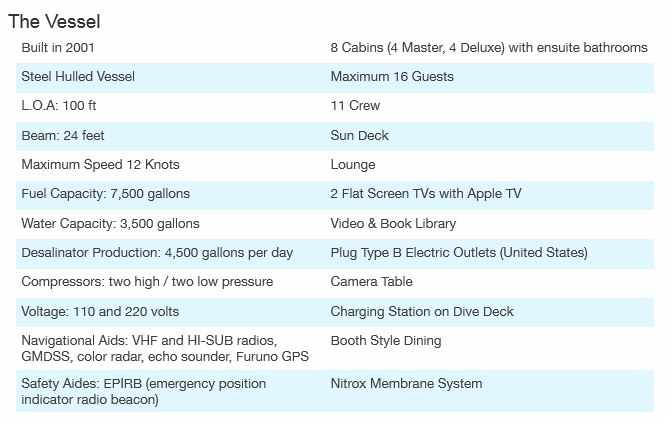Galapagos Sky
The 100-foot Galapagos Sky features four master cabins with a queen bed or, by request, two twin beds. The four deluxe cabins have two twin beds. All cabins have private bathrooms, wardrobes, hair dryers and bathrobes. The master cabins are also equipped with televisions with DVD players. The yacht offers Nitrox and has two dive tenders.
The lavish lounge and dining area onboard MV Galapagos Sky are fully air conditioned with stylish, comfortable seating. The main salon is equipped with a large television and full entertainment system, perfect for viewing photos and video of the day’s exciting dive adventures.
Scuba divers will enjoy up to four thrilling dives each day. This vessel was designed for diver comfort and features dive platforms, fresh water showers, equipment and camera rentals, gear storage, Nitrox, two dive masters and fresh warm towels after every dive. Galapagos Sky takes scuba divers to the best dive sites including Wolf and Darwin Islands where Galapagos sharks, hammerheads, turtles, schools of tuna, manta rays, whale sharks and white tip sharks can be found.
The Galapagos Islands are the crossroad for the Equatorial Counter Current and colder Humboldt Current of South America, thus providing an area rich with nutrients and food for the numerous marine creatures. Whales, whale sharks, dolphins, sea lions, sharks – especially hammerheads – turtles and jacks join the many other species crossing your path as you cruise through these prolific waters.

Sunday (Embarkation day):
• Isla Lobos- Check out dive
When you arrive at the airport at San Cristobal on Sunday (Avianca flight 1636), the crew of the Galapagos Sky will personally meet you, collect your luggage, and escort you to the Galapagos Sky. Your luggage will be delivered to the dive deck for you. After everyone is on board, we will introduce you to the boat and do our mandatory safety briefings and drill. Then, we cruise to the area of Los Lobos for your check-out dive.
This will be your first underwater introduction to Galapagos sea lions and fur seals! Watch them Zoom in and out and dance playfully for you!
Even on the first day of your live-aboard cruise – you begin to see the myriad and diverse land formations which comprise the Galapagos Islands topside. It is then you realize you will see nothing like it in your lifetime.
Monday
• Northeast tip of Isla Pinzon/Islote Dumb- 1 dive
• Cousins 2 dives
Isla Pinzon – While diving Isla Pinzon you will be provided opportunities for encounters with a variety of species of sharks, sea lions, mantas, eagle rays, and moray eels. Many Species of fish and tropicals including yellow tailed surgeonfish, king angelfish, moorish idols, steel pompanos, snappers, grunts, creole fish, and barracuda.
Cousins Rocks– this dive is an itinerary favorite and is done along a beautiful wall and allows for great viewing opportunities for corals, frog fish, sea horses, scorpion fish and octopus. It is also a great dive for large schools of Barracuda and also Hammerhead shark sightings. Sea lions will be your companions upon entry and on the safety stops.
By definition, the entire Galapagos Archipelago is geographically remote. But after this day of your live-aboard cruise finds you heading toward the most isolated, northernmost part of the Galapagos Islands – the uninhabited, untouched, twin cathedrals of world class diving – Wolf and Darwin Islands.
Tuesday-Thursday- Wolf & Darwin
• Tues-4 Dives a day at Wolf plus a night dive
• Wed- 4 dives at Darwin
• Thurs-3 Dives total, 2 at Darwin and 1 afternoon dive at Wolf before long transit back to central islands
Diving Wolf and Darwin
You’ll spend the next three days diving (up to four dives per day plus a night dive) the legendary islands of WOLF & DARWIN.
Most experienced divers will agree, Wolf and Darwin can provide some of the best diving encounters in the world! Whale sharks are common here from Mid May through November. At The Arch at Darwin, you will see hammerhead sharks either individually, in small groups, or large schools. Bottlenose dolphins are common. The reef contains many warm water varieties of fish found nowhere else in the Islands.
Once you see Wolf and Darwin – you’ll immediately understand why there are no shore excursions on this part of the cruise – there is no way up the vertical cliffs!
Darwin Island: Considered by many experienced divers as the very best dive site in the world, The Arch at Darwin island (actually several dive sites depending on where you enter, currents, etc) honors its reputation. It is warmer by a few degrees than the central islands. In one single dive you can find schooling hammerhead sharks, Galapagos sharks, large pods of dolphins, thick schools of skipjack and yellow fin tuna, big eye jacks, mobula rays, and silky sharks. From June to November, it is not uncommon to encounter whale sharks in multiple numbers on one single dive. The presence of occasional tiger sharks, black and blue marlin, and killer whales adds on to this amazing diving experience. If you still have time to look for smaller stuff, you’ll find octopus, flounders, and an enormous variety and abundance of tropical fish. Darwin Island is the biggest jewel on the Galapagos Crown.
Wolf Island: One of those magical islands, with several dive sites to choose from. If you want to see sharks, you are at the right spot. This is a place for schooling hammerhead sharks, large aggregations of Galapagos sharks, and occasionally whale sharks. Seeing dolphins, large schools of tuna, spotted eagle rays, barracudas, sea lions and sea turtles is common. The bottom is littered with hundreds of moray eels, many of them free swimming. Being several degrees warmer than the central islands, you can look for many representatives of the Indo-Pacific underwater fauna. On a night dive here you will also enjoy spotting and watching the Red Lipped bat fish walk along the bottom of the sea!
Friday
• Cabo Douglas 1 dive – Marine iguana dive
• Punta Vicente Roca up to 2 dives and Panga ride if time allows.
Cabo Douglas: On the western side of Fernandina Island, we will do 1 dive Friday morning. Here you can expect to see Galapagos Penguins, Marine Iguanas, Flighless Cormorants, Sea Lions, Seahorse, Sea Turtles, Horn Sharks, Red Lipped Batfish, and occasional hammerhead sharks and white tip sharks. Also keep an eye out for chevron barracuda, snappers, yellow fin tuna, rainbow runners, and wahoo. There are also a lot of smaller fishes like creole fishes, parrot fishes, scrawled filefishes, pacific box fishes, and tiger snake eels.
Punta Vincente Roca: Our coldest yet rapidly increasing favorite dive – steep, deep vertical wall covered in soft coral, sponges, and endemic black coral. Regular sightings of mola mola (oceanic sun fish,) sea horses, bullhead sharks, red lipped bat fish, various shrimp and many other marine invertebrates. Keep your eyes open for fly bys from the flightless cormorants, penguins and maybe even a marine iguana. Our after-dive panga ride offers great topside photo ops for penguins, flightless cormorants, marine iguanas, sea lions, blue footed & nazca booby Birds, magnificent frigates and noddy terns. The diving here is chilly (particularly below the thermocline – but not to be missed!).
Saturday
• Bartolome Land walk and 1 dive
• Puerto Ayora/Highlands tour
Bartolome is a lovely area where guests enjoy a favorite land tour where they can climb to the top of the hill to where breathe taking views abound. Followed by diving at Bartolome where penguins can be seen.
This dive is then followed by a transit to Itabaca Channel where guests will be transferred by bus (at approx. 1400h and approx.. 45 minute ground transfer) to visit the Highlands of Santa Cruz to see the Galapagos Tortoises in their natural environment; and visit to Puerto Ayora. Guests will then be transferred back to Itabaca Channel to board the Galapagos Sky approx. 1900h. The Sky will then return to San Cristobal for Sunday morning cruise completion.
Sunday Morning- Land Tour and Day of Departure
• Interpretation center.
Arrive San Cristobal—(Land Excursion) visit the Interpretation Center where an interesting human history of Galapagos is presented, town walk (last chance for shopping). Late morning departure.

Diving and Conditions in Galápagos
Please note that diving in the Galápagos is advanced due to strong currents, varying visibility and cold water. Temperatures range from low 60's to upper 70's in different areas of the itinerary and seasons. Depths can be 20-30 meters or 65-100 feet. Divers must be comfortable in these conditions, as well as have very good buoyancy and be able to do negative (sometimes rapid) back-roll entries/descents from small boats.
Recommended requirements include 50-100 open water dives, experience in currents, ability in removing gear in water and ability in getting into small boats in choppy seas. Nitrox certification prior to the cruise is highly recommended. Recent dive experience required.
All diving off M/V Galápagos Sky is NON- DECOMPRESSION diving, no exceptions.
Diver to Dive Guide Ratio
8:1 With a full boat of 16 guests, divers will be placed in two groups of 8. Each group of 8 divers will have 1 Dive Guide.
Private Dive Guide Services
For divers who wish to have a Private Dive Guide, an extra guide can be made available for $1750 per week. Private Dive Guide services must be made well in advance and are contingent to Dive Guide availability. The fee is added to the reservation invoice and payment is made in advance.
Certification Cards
Certification cards must be shown to Dive Guides when checking in at the beginning of the cruise. Highest level of training and Nitrox card please.
Dive Computers
Divers must use a dive computer or be able to show dive planning with a dive table to the dive guide to keep track of their non-decompression time. Rental dive computers are very limited so it is strongly suggested that each diver bring their own dive computer with a back-up dive computer, ideally with the same algorithm. If your dive computer is violated you will not be allowed to dive until the computer has cleared.
Minimum Age
As the dive itinerary does not offer dives under 40ft/12m, divers must be at least 15 years old with proper training and experience.
Solo Diving/Side Mount/Rebreather
At this time, Solo Diving, Side Mount diving or Rebreathers are not permitted. Stage or pony bottles are not available for rent.
Night Diving
Night dives are optional and conducted weather and conditions permitting on Day 3 at Wolf. Divers must be experienced at night diving, carry a primary and a backup light/torch and also have a tank light. Underwater lights/torches are not available for rent or loan.

